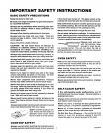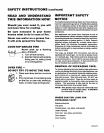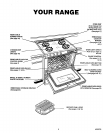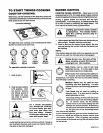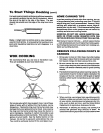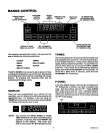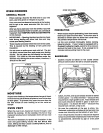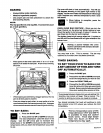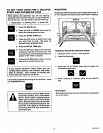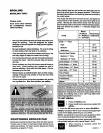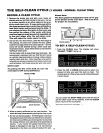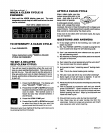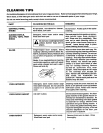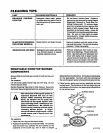
OVEN COOKING OVENVENTAREA
GENERAL RULES
When cooking a food for the first time in your new
oven, use time given on recipes as a guide.
Your new oven has been set correctly at the factory
and Is apt to be more accurate than the oven It
replaced.
After you have used your oven for awhile, If you feel
your oven should be hotter or cooler, you can adjust
tt yourself. See TEMPERATURE ADJUSTMENTS
in this manual.
NO PEEKING--Opening the door too often to check
food during baking will allow heat loss and may
cause poor baking results.
There may be some odor when the oven Is first used.
This Is caused by the heating of new parts and
Insulation.
Do not cover an entire oven rack with foil. The foil
can block normal heat flow and cause poor baking
results. Do not place any foil directly on the oven
bottom. Foil used on the oven bottom under the
element may damage the oven surface, therefore, it
should not be used.
/
)
PREHEATING
When recipes require preheating, have food nearby
before you open the oven door. If the oven door Is
allowed to remain open for more than a brief time,
the preheat temperature will be lost.
Let the oven preheat thoroughly before cooking
baked products. If your range is equipped with a
Preheat Indicator Light, watch for It to come on
and put the food In the oven. If not, preheat for 10
minutes before putting food In the oven.
BAKEWARE
Cookies should be baked on flat cookie sheets
without sides to allow the air to circulate properly.
MOISTURE
As your oven heats up, the temperature change of the air
in the oven may cause water droplets to form on the door
or door glass. To prevent this, open the oven door for
the first minute of oven heating to let the moist air
escape.
OVEN VENT
When the oven Is on, heated air moves through a vent
behind the cooktop. On the cooktop, this hot air may
make pot handles hot or melt plastic items left too near
the vent.
The vent is necessary for proper air circulation in the
oven and good baking results. Do not block this
vent. Doing so may cause cooking failure, fire or
damage to the range.
Cakes, muffins, and quick breads should be baked
in shiny pans -- to reflect the heat -- because they
should have a light golden crust. Yeast breads and
pie crusts should be baked In glass or dull (non-
shiny) pans -- to absorb the heat -- because they
should have a brown, crisp crust.
Be sure the underside of the pan is shiny, too.
Darkened undersides will absorb the heat and may
cause over-browning on the bottom of your food.
Oven temperatures should be reduced 25 degrees
below recommended temperatures if exterior of pan
is predarkened, darkened by age or oven proof
glass.
11 NGOVC13




